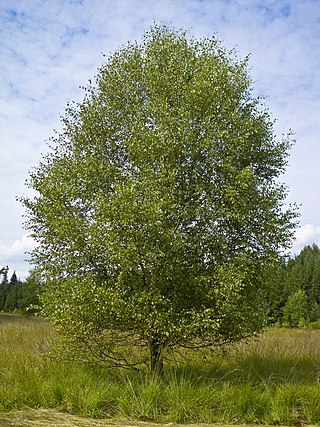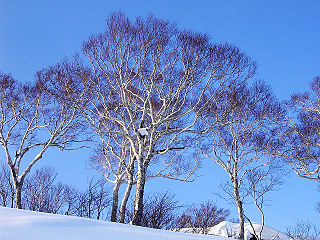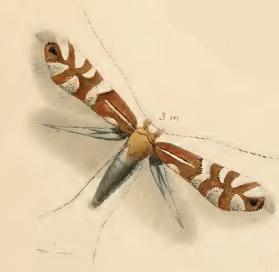
A birch is a thin-leaved deciduous hardwood tree of the genus Betula, in the family Betulaceae, which also includes alders, hazels, and hornbeams. It is closely related to the beech-oak family Fagaceae. The genus Betula contains 30 to 60 known taxa of which 11 are on the IUCN 2011 Red List of Threatened Species. They are typically short-lived pioneer species and are widespread in the Northern Hemisphere, particularly in northern areas of temperate climates and in boreal climates. Birch wood is used for a wide range of purposes.

Betula pendula, commonly known as silver birch, warty birch, European white birch, or East Asian white birch, is a species of tree in the family Betulaceae, native to Europe and parts of Asia, though in southern Europe, it is only found at higher altitudes. Its range extends into Siberia, China, and southwest Asia in the mountains of northern Turkey, the Caucasus, and northern Iran. It has been introduced into North America, where it is known as the European white birch or weeping birch and is considered invasive in some states in the United States and parts of Canada. The tree can also be found in more temperate regions of Australia.

Betula pubescens, commonly known as downy birch and also as moor birch, white birch, European white birch or hairy birch, is a species of deciduous tree, native and abundant throughout northern Europe and northern Asia, growing further north than any other broadleaf tree. It is closely related to, and often confused with, the silver birch, but grows in wetter places with heavier soils and poorer drainage; smaller trees can also be confused with the dwarf birch.

The hama yumi is a sacred bow (yumi) used in 1103 A.D. in Japan. This bow is said to be one of the oldest and most sacred Japanese weapons; the first Emperor Jimmu is always depicted carrying a bow.

Betula papyrifera is a short-lived species of birch native to northern North America. Paper birch is named after the tree's thin white bark, which often peels in paper-like layers from the trunk. Paper birch is often one of the first species to colonize a burned area within the northern latitudes, and is an important species for moose browsing. Primary commercial uses for paper birch wood are as boltwood and sawlogs, while secondary products include firewood and pulpwood. It is the provincial tree of Saskatchewan and the state tree of New Hampshire.

Betula alleghaniensis, the yellow birch, golden birch, or swamp birch, is a large tree and an important lumber species of birch native to northeastern North America. Its vernacular names refer to the golden color of the tree's bark. In the past its scientific name was Betula lutea, the yellow birch.

Betula nana, the dwarf birch, is a species of birch in the family Betulaceae, found mainly in the tundra of the Arctic region.

Betula platyphylla, the Asian white birch or Japanese white birch, is a tree species in the family Betulaceae. It can be found in subarctic and temperate Asia in Japan, China, Korea, Mongolia, the Russian Far East, and Siberia. It can grow to be 30 metres tall.

Betula ermanii, or Erman's birch, is a species of birch tree belonging to the family Betulaceae. It is an extremely variable species and can be found in Northeast China, Korea, Japan, and Russian Far East. It can grow to 20 metres (66 ft) tall. It is noted for its peeling bark, which can sometimes be removed in sheets, but usually shreds and hangs from the trunk and under branches. Yellow-brown male catkins appear with the leaves in spring.

Ectoedemia occultella, the small birch leafminer, is a moth of the family Nepticulidae. It has a Holarctic distribution. It is found in most of Europe, east through Russia to Japan. It is also present in North America. Mines very similar to that of Ectoedemia occultella have been found on Rosaceae species in Nepal and Japan and these may belong to this species.
Phyllonorycter cavella is a moth of the family Gracillariidae. It is known from all of Europe, east to Japan and Russia.

Phyllonorycter ulmifoliella is a moth of the family Gracillariidae. It is found in all of Europe, east to Russia and Japan.
Caloptilia pyrrhaspis is a moth of the family Gracillariidae. It is known from China (Sichuan), Japan and the Russian Far East.

Bucculatrix demaryella is a moth of the family Bucculatricidae. The species was first described by Philogène Auguste Joseph Duponchel in 1840. It is found in most of Europe, Russia and Japan.

Synanthedon scoliaeformis, the Welsh clearwing, is a moth of the family Sesiidae. It is found from almost all of Europe, east through Russia to Japan.
An azusa yumi is a sacred bow (yumi) used in certain Shinto rituals in Japan, as well as a Japanese musical bow, made from the wood of the Japanese azusa or Japanese cherry birch tree. Playing an azusa yumi forms part of some Shinto rituals; in Japan, it is believed that merely the twanging of the bowstring will frighten ghosts and evil spirits away from a house. In Japanese poetry, the word azusa yumi functions as a makurakotoba.

Betula grossa, commonly known as Japanese cherry birch, is a species of birch native to Japan, where it grows naturally in mixed woodland on hill and mountain slopes in Honshu, Shikoku, and Kyushu. It was introduced to the West in 1896, but remains rare in cultivation.












